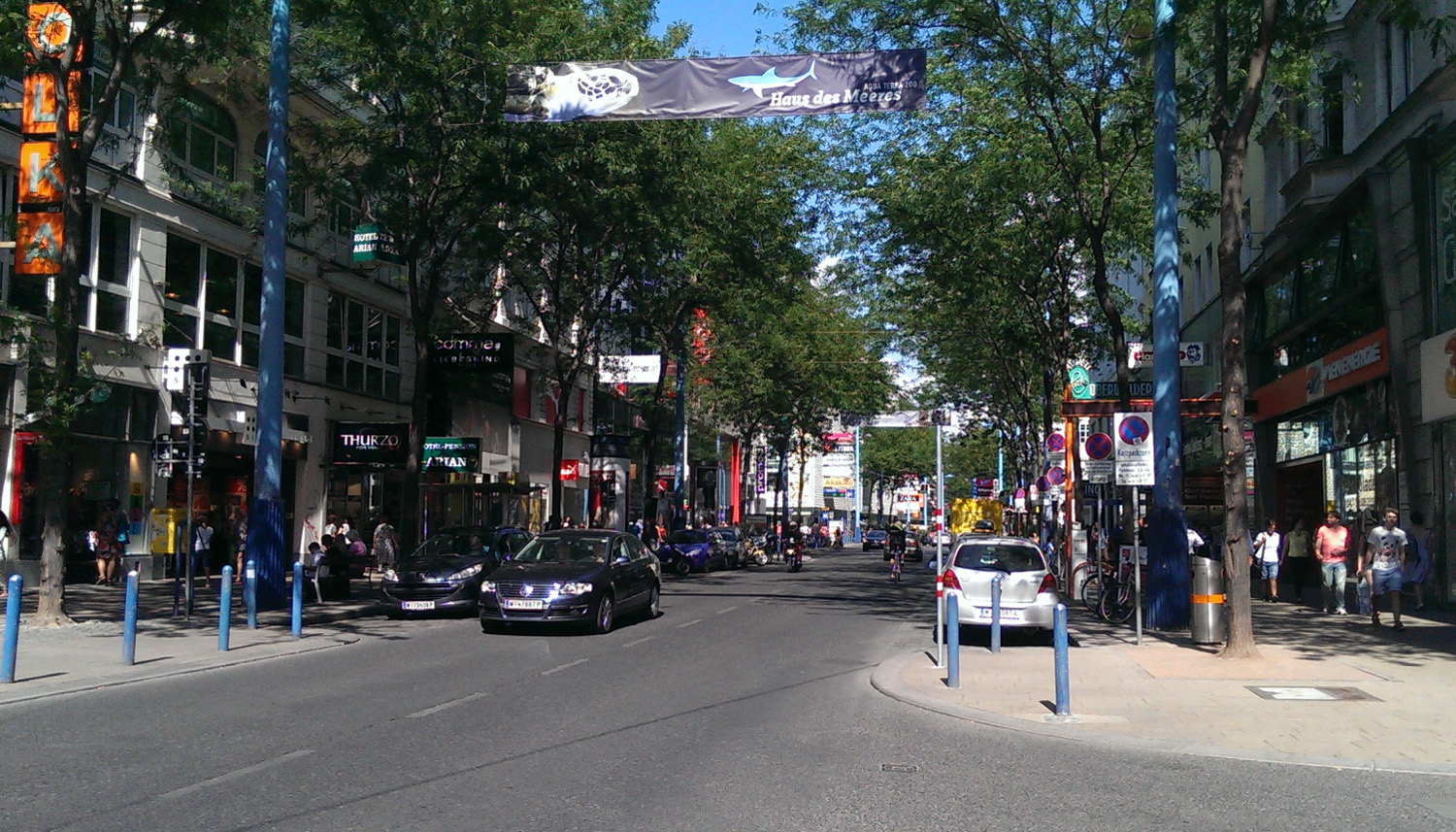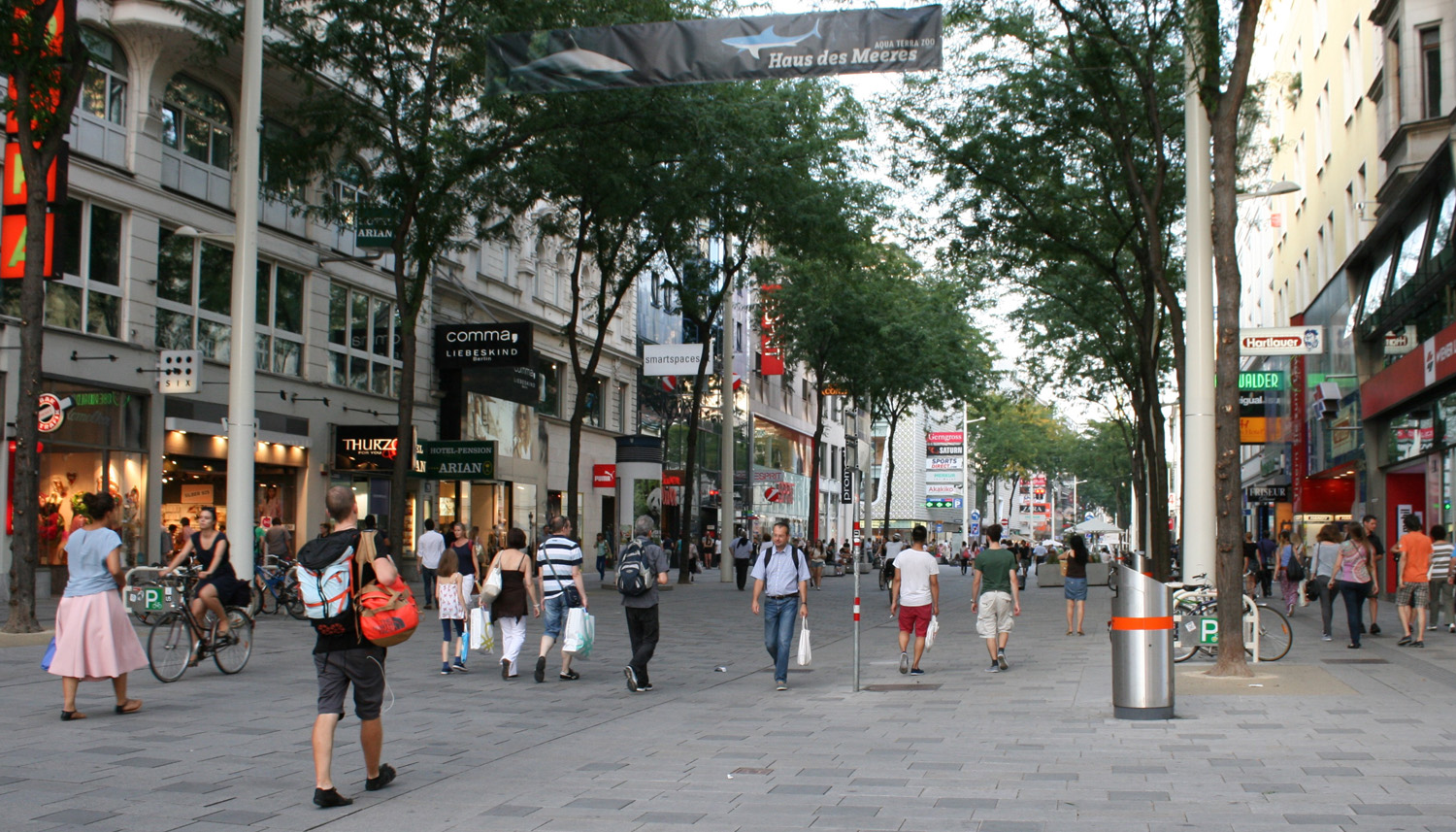There are few streets in San Francisco as iconic as Haight Street. At the epicenter of the American cultural revolution of the 1960s, Haight Street is anything but ordinary.
And yet we treat it like it's nothing special.
Everyone is crammed along the edges.
(Yet somehow everything still tries to cram into that tiny little space, making walking down Haight Street near impossible for those of us who just want to get groceries at Haight Street Market or stop by Robert's.)
That's Boulder, Colorado. They literally took a street filled with hippies and celebrated it, put in public restrooms, and made the street plenty wide enough for everyone to have a place.
Well, it turns out, it works in cities all over the world. Here's an example of a before and after in Vienna.
Photo credits: CC GuentherZ – Wikimedia Commmons / Andreas Lindinger – Vienncouver.com
There is virtually no better place in San Francisco to reinvent the street than Haight, with high foot traffic from tourists, shoppers, and neighbors alike.
We start by switching the percentage around...
...until the street favors people
(Ahh, room to breathe...)
This really changes everything.
From Buena Vista Park to Golden Gate Park, a Whole New Haight Street.
Parking
A total increase of 20–30 parking spaces are created by moving to perpendicular parking on streets within one block of Haight.Muni
Muni would continue to run at low speeds on Haight St. in a shared-street capacity. 3 consolidated stops, each a 5-minute walk away.Loading
During specified times, bus-only lanes can be used by delivery vehicles, while designated areas can be used as loading zones.Eventually, we could even split the F Market and run trains down Haight Street.
Plenty of space to walk and enjoy the streetlife, better transit options, more parking, a safer street for both neighbors and tourists, and a true celebration of Haight Street.
What's not to love?
Update!
We've received a few fun neighbor-submitted visions. Here are a few more examples of what a revolutionized Haight Street could look like.
FAQ
What about the Haight Street Public Realm Plan?
The Haight Street Public Realm Plan laid out a great framework on which to build something grand. There are some great takeaways, and the data shows people are looking for ways to help take Haight Street to the next level. But let's be honest: that project barely scratches the surface—and yet is somehow complex. If we're going tear up Haight Street, we should do this right. This sort of opportunity doesn't come around all the time, and the minor types of changes outlined are almost not worth the money and time spent. Haight Street deserves better, and we think we can do a better job helping tell the City what we want.
Do you believe in "identity features"?
This is something the SFMTA brings up a lot. We feel that identity is defined primarily by the people and the businesses. That doesn't mean there isn't room for some amazing art, music, lighting, and cultural elements, but they should be done by the community and neighborhood, not planners.
What happens to all the parking?
Amazingly, by simply switching streets within one block of Haight Street to perpendicular parking, we would actually gain 20–30 additional parking spaces over what we have available today. If we wanted to go one step further, lower-traffic streets like Belvedere and Shrader (or even Masonic south of Haight) could be converted to one-way, which would add an additional 40-70 parking spaces, while also slowing down traffic on these cozier neighborhood streets.
But can I park as close?
Well, let's face it. Finding a parking space on Haight Street today is pretty difficult already. By adding more parking spaces on neighboring streets, you'll have a much better shot at finding parking closer than you do today. This will have a particularly strong benefit to neighbors.
Where does Muni go?
Right down the center of the street! A shared pedestrian/transit space model is in use in cities around the world to help split space between low-speed transit vehicles and people walking on the street. In fact, many cities have found that this model even has the potential to decrease how long it takes a transit vehicle to move through a space, while maintaining human-friendly speeds of below 10mph. Some cities even equip their buses and trains with a friendly pedestrian bell to help inform people that they should step out of the way.
I'm a merchant, will this hurt business?
All signs point to the exact opposite. The vast majority of people shopping along Haight Street arrive by a means other than private vehicle already, and making Haight Street a better destination will only help increase foot traffic. Making Haight Street a more hospitable space will also help bring more neighbors onto the street far more frequently.
What about crime?
Pedestrian zones typically have far lower crime, due in part to the increase in street activity and the better indoor-outdoor connections between businesses and the street. It's also a great opportunity to work with SFPD to increase neighborhood patrols on foot and bike (or horse!) Police on the street instead of in cars is a great way to better integrate with neighbors and build a better community.
Does this make Haight Street a Tourist Trap?
Certainly not! A common refrain from business owners on Haight Street today is, in fact, that the majority of their clients are tourists. We need to get more neighbors onto the street to support our local businesses, and the best way to do that is to give us a reason to be there. Having enough space means we can walk with grocery bags in hand past tourists taking photos. Integrating the indoors and outdoors means more vibrancy and a family-friendly atmosphere. Better streetwide pavement and transit loading zones means a more accessible street.
Is this a ploy by the City?
Honestly, it's sort of the opposite. We weren't happy with what the city was proposing, so we've decided to create our own. Everyone who has contributed to this vision lives or works in this neighborhood. Many of us aren't thrilled with a lot of the direction we're seeing in architecture and urban design in San Francisco, and we wanted to find a way to let Haight Street shine. Making this street have more space for people means more community. Rather than "wayfinding" or "identity features," we want more art, more music, and more culture. All of those human elements come from us, those who live and work in this neighborhood.
Will this make for crazy traffic?
Traffic volumes in upper Haight revolve predominantly around the arterial routes of Masonic, Fell, Oak, and Stanyan, all of which would remain. By adding more parking and better transit access, we can seek to reduce the amount of time people spend driving looking for parking, which makes up anywhere from 40-70% of traffic on and around Haight Street. It also gives us a great opportunity to evaluate cross-streets because, frankly, crossing Haight today isn't easy.
What about taxis, Lyfts or Ubers?
You will be able to pick up ridesharing services at every cross street, and some cities have found success with short passenger loading zones on cross-streets to minimize circling, both for rideshare services and for anyone who needs to be picked up or dropped off. Some cities have experimented with allowing taxis on bus-only lanes at specified hours (e.g., after bars close at 2am.)
What about loading zones for deliveries?
Designating space on each block for temporary delivery vehicle parking gives delivery vehicles a space to park that doesn't interfere with transit or require double-parking. Many cities have seen success with specified delivery hours to minimize the impact on streetlife, something that Haight Street merchants would want to determine.
The ideas are great, but will it work?
One critical piece of the puzzle is letting our local stores spill out into the streets. Restaurants like Citrus Club, Magnolia, and Sparrow should be able to have large wind-protected seating areas right out front. Quick food spots like Escape From New York, Street Taco, and Crepe Express should have the ability to sell directly to the street. Love of Ganesha, Held Over, and Loved to Death can bring their gifts and curiosities out into the open. The Upper Haight farmer's market could come back right on Haight Street. Robert's Hardware can expand their garden section out front. Bringing the inside out is one of the best ways we can help make Haight Street a far better destination for everyone.
Who are you?
My name is Reed Martin, resident of Upper Haight for a decade. I started this project in response to a number of Haight Street residents and business owners not being happy with the end result of the Haight Street Public Realm Plan. There was a growing feeling that that plan would be a lot of work without meeting the diverse needs of Haight Street. I've been working hard to gather ideas and opinions from a number of residents and business owners to shape this vision for a Haight Street for the people—something we feel this street has always been about.

